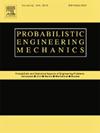System identification and reliability assessment of hyperelastic materials via an efficient sparsity-promoting variational Bayesian approach
IF 3
3区 工程技术
Q2 ENGINEERING, MECHANICAL
引用次数: 0
Abstract
In this study, an efficient data-driven approach to identify constitutive models for isotropic hyperelastic materials is introduced, which is crucial for predicting material behavior and subsequently evaluating its reliability. This innovative method allows for reliability assessment, even when the precise material model is unknown beforehand. First, a data-driven physics-preserving approach for identifying constitutive models that describe the stress–strain relationships of isotropic hyperelastic materials is developed. A manually designed library of polynomial basis functions inspired by existing models for rubber-like materials is utilized. To achieve a sparse selection of features from this library, a Bayesian sparse regression technique is employed, implementing a sparsity-promoting spike-and-slab prior. Instead of using the computationally intensive Markov Chain Monte Carlo (MCMC) method for Bayesian posterior inference, a more efficient Variational Bayesian (VB) approach is opted for, significantly reducing computational time. The effectiveness of the constitutive model identification procedure is demonstrated through various numerical examples. Next, attention is turned to the estimation of reliability for hyperelastic materials under parametric uncertainty. Given that the constitutive model is unknown beforehand, multiple specimens of the material are utilized to determine a common underlying model and identify parameter distributions. These parameter distributions are then employed to estimate the Probability of Failure (PF) through Monte Carlo simulations. The results showcase the versatility of the proposed approach, not only in predicting material behavior and calibrating models but also in calculating the PF for hyperelastic materials, even in situations where the underlying model is not known in advance.
超弹性材料的系统辨识与可靠性评估,基于有效的稀疏性提升变分贝叶斯方法
本研究介绍了一种高效的数据驱动方法,用于确定各向同性超弹性材料的构成模型,这对于预测材料行为以及随后评估其可靠性至关重要。即使事先不知道精确的材料模型,这种创新方法也能进行可靠性评估。首先,开发了一种数据驱动的物理保留方法,用于识别描述各向同性超弹性材料应力-应变关系的构成模型。受现有类橡胶材料模型的启发,利用人工设计的多项式基函数库。为实现从该库中稀疏选择特征,采用了贝叶斯稀疏回归技术,实施了稀疏性促进尖峰和平板先验。在贝叶斯后验推理中,没有使用计算密集型的马尔可夫链蒙特卡洛(MCMC)方法,而是选择了更高效的变异贝叶斯(VB)方法,从而大大减少了计算时间。通过各种数值示例证明了构成模型识别程序的有效性。接下来,我们将注意力转向参数不确定情况下超弹性材料的可靠性估算。鉴于构成模型事先是未知的,因此利用材料的多个试样来确定一个共同的基本模型并识别参数分布。然后利用这些参数分布,通过蒙特卡罗模拟估算失效概率 (PF)。结果展示了所提方法的多功能性,不仅能预测材料行为和校准模型,还能计算超弹性材料的 PF,即使是在事先不知道基础模型的情况下。
本文章由计算机程序翻译,如有差异,请以英文原文为准。
求助全文
约1分钟内获得全文
求助全文
来源期刊

Probabilistic Engineering Mechanics
工程技术-工程:机械
CiteScore
3.80
自引率
15.40%
发文量
98
审稿时长
13.5 months
期刊介绍:
This journal provides a forum for scholarly work dealing primarily with probabilistic and statistical approaches to contemporary solid/structural and fluid mechanics problems encountered in diverse technical disciplines such as aerospace, civil, marine, mechanical, and nuclear engineering. The journal aims to maintain a healthy balance between general solution techniques and problem-specific results, encouraging a fruitful exchange of ideas among disparate engineering specialities.
 求助内容:
求助内容: 应助结果提醒方式:
应助结果提醒方式:


